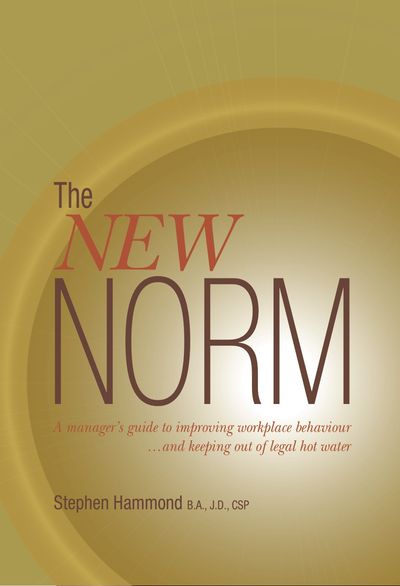Chapter thirty three
THE NEW NORM uses common sense
My mother used to say she never worried about me because I had common sense. She also said I could run fast and I knew when to run. I guess the running was part of my common sense. We like to think everyone has common sense, but unfortunately, it’s not always that common. I’m surprised how many times I say to myself (or my spouse), “Has the whole world gone loopy?” Let me give you two rather high-profile examples (ongoing as I write this).
In January, 2016, front-page headlines and most TV, radio and internet news outlets covered the story of the six-year-old Canadian boy who was having trouble with security at Toronto Pearson Airport. On December 31, 2015, he and his dad were flying to the NHL Winter Classic hockey game in Boston for New Year’s Day.
While at the airport the father tweeted a picture of an Air Canada computer screen with his son’s name on it and wrote, “Why is our (Canadian-born) six-year-old on DHP [deemed high profile] no-fly list? He must clear security each time. He is six. :).”
“Deemed high profile” means this boy warrants extra attention at the airport and his parents can’t arrange for their boarding pass ahead of time.
While no one has supplied an official reason for this family’s problems, I’d say it is clear that this six-year-old has the same name as some person on the American and/or Canadian “no fly list,” as governed by the Secure Air Travel Regulations. Many other people, adults and children, have this same problem.
The Globe and Mail wrote a cover story depicting an adorable twenty-one-month-old child whose parents go through the same hassle each time they fly within Canada. While their son always gets on the flights, the parents say it takes an additional ten to twenty minutes of extra safety measures.
I’m quite sure some airport and security people could have benefited by taking my
Respectful Workplace online course where I spell out the importance of proper and fair procedures to address workplace discrimination.

I’m quite sure some airport and security people could have benefited by taking my Respectful Workplace online course where I spell out the importance of proper and fair procedures to address workplace discrimination.
Shortly after the dad’s airport tweet, Ralph Goodale, Canada’s federal safety minister, reminded Canadian airlines that they don’t need to check children against Canada’s no-fly list. But why does a very busy guy like Goodale have to take time to respond to this issue?
Isn’t it common sense? When we say “zero tolerance,” we leave the smarts out of the equation. After all, when security resources are diverted to babies, I as a frequent flyer worry about the time not being used to catch the real threats on my plane.
Here’s another case that arises due to lack of common sense. In early January, 2016, dentist Michael Flunkert got media attention when he sent a letter of complaint to the premier of B.C. about a policy from his College of Dental Surgeons of B.C. In its legitimate desire to prevent sexual exploitation of patients, the college takes a literal interpretation of the provincial Health Professions Act which states that there can be no sexual relations between dentists and patients.
The problem is, Flunkert and many other dentists treat their married spouses. Therefore, if you’re having sex with your husband or wife, you’re in violation of the Act.
It appears that no other province prevents dentists from treating their spouses, so the question is, why in B.C.? Here’s where common sense is lacking. Sure, professional associations are under a lot of pressure to ensure the safety of people served by their members.
And horrible examples of sexual abuse between health care providers and their patients have led to legitimate strict regulations. It’s just that again, “zero tolerance” doesn’t fit every situation. That’s where common sense has to kick in with someone asking, “Wait a minute, what is our intention?”
In the workplace, I regularly hear of organizations taking a “zero tolerance” approach to harassment, bullying, discrimination and other inappropriate behaviours. However, the law doesn’t accept “zero tolerance” and in fact, many employers get into trouble for blindly adhering to this idea when what they should be doing is thinking, “what harm do we want to prevent?” and “how do we need to approach this particular situation?”
Perhaps a particular approach applies to ninety-eight percent of behaviours, but doesn’t fit the other two percent. Use common sense to distinguish between the two.
The OLD NORM
- has the best of intentions when trying to solve a problem by following a policy or procedure.
- makes the mistake of following policies blindly, as opposed to thinking about the intent of the policy and what it’s meant to truly do.
- gives into pressure from others to follow the letter of the “law” as opposed to thinking independently.
- doesn’t use common sense.
The NEW NORM
- knows the importance of policies and follows them, but gives thought to exceptions when needed.
- thinks, “what’s the best way to solve this problem?” or “what is the intention here?” before blindly following a procedure that has worked very well for similar situations.
- does not give into pressure from others to follow the herd.
- uses his common sense, as well as the proper policies and procedures.
Suggestions for the New Norm:
01
Give the time to save a lot of time. This book chronicles many examples of people taking a knee-jerk reaction to a situation, not taking the time to think things out. Who can be faulted for taking decisive and firm action against a person accused of racial harassment? Well, the fault lies in not taking into consideration all of the facts, and making a decision based on those facts rather than on one person’s (or your own) emotions. Taking the time to make the right decision can save you enormous time later if someone takes you into a legal process or steers you into a public relations nightmare due to banner headlines.
02
If something doesn’t seem right, speak up. I can hear my father say, “If Jack jumped off a bridge, would you? (Amazing how much we can learn from our parents.) Just because everyone else wants to go along with certain responses doesn’t mean it’s the right thing. If your gut, or common sense, tells you your leadership team is making the wrong decision, it’s incumbent on you to speak up. Doing so after things explode in everyone’s face is too late.
03
Help people with their common sense. I believe everyone has a certain degree of common sense, but sometimes people don’t follow it. Perhaps assist a person to see the common sense.
This chapter emphasizes the importance of using common sense to deal with many issues, including harassment, bullying and discrimination at work.
For another example of the need to use common sense, consider reading
Chapter 13: The New Norm doesn’t engage in “baffling and bizarre” workplace behaviour.
Purchase a copy of The New Norm, or if you think all your supervisors and managers, could learn many valuable lessons about creating a respectful workplace, free of harassment, bullying and discrimination, you can get volume discounts.
What one reader has to say about Stephen’s book, The New Norm
“Stephen’s book is a brilliant reminder of workplace situations that are disturbing, yet slip by unaddressed by so many in both the private and public sector. When these behaviours are unaddressed, they become the norm because we allow them to be.
Just like his first book, Stephen is insightful, his writing is moving and he inspires his readers to take immediate action to disapprove of, and address harassment and other inappropriate behaviour every time we see it, feel it and hear about it. In a concise format, he gives us a series of snapshots of old vs. new, acceptable vs. unacceptable, right vs. wrong, in a way that is understandable.
If workplace leaders take just some of Stephen’s practical advice, they will go a long way to rid their workplace of unacceptable behaviours such as harassment, discrimination and bullying. It’s clear that to create Stephen’s “New Norm,” we need to ACT NOW! We can’t wait any longer.”
Tatjana Zatezalo
Manager, Organizational Development, Halifax Regional Municipality

Respectful Workplace Online Training Course
If you, your employees or your managers want more information,
sign up for my new online training course:
The Respectful Workplace in Canada.
With 10 modules of useful, relevant and current information,
this course can help everyone at your workplace.
This may be the best online harassment training your people will get.
Stephen Hammond is a lawyer turned speaker and consultant in the field of harassment, sexual harassment, bullying and discrimination at work.
The New Norm is Stephen’s third book.
Here’s more information about Stephen.



